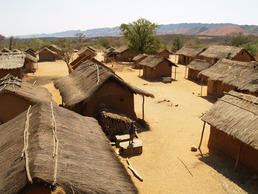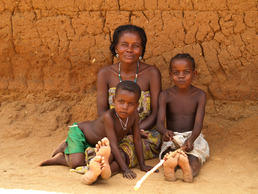Information on our work among the Bara
Village view Sakafutsy
Image Credit: Gabriel Scheidecker
Village view Sakafutsy
Image Credit: Gabriel Scheidecker
Cultural context
The Bara are one of 17 different ethnic groups living on the island state of Madagascar. Despite the geographical proximity to the African continent, the language of the Madagascan population belongs to the austronesian family of languages – which is the concordance linking the Bara with the other two research cultures of the project. Linguistic comparisons proved that the language closest related to Madagascan is spoken in southern Borneo by members of the Dayak population. In archeology, there is a broad consensus that in the first half of the first century A.D., Madagascar was populated (starting) from Indonesia. Today there are asserted significant influences, besides the Indonesian, from African Bantu groups, Arabic mariners and salesmen and also, recently, from European appropriation, especially due to the French colonisation.
Environment and ecnomy
The Bara are one of 17 different ethnic groups living on the island state of Madagascar. Despite the geographical proximity to the African continent, the language of the Madagascan population belongs to the austronesian family of languages – which is the concordance linking the Bara with the other two research cultures of the project. Linguistic comparisons proved that the language closest related to Madagascan is spoken in southern Borneo by members of the Dayak population. In archeology, there is a broad consensus that in the first half of the first century A.D., Madagascar was populated (starting) from Indonesia. Today there are asserted significant influences, besides the Indonesian, from African Bantu groups, Arabic mariners and salesmen and also, recently, from European appropriation, especially due to the French colonisation.
Social and religious structure
Due to the scant environment and accordingly the extensive economy, the Bara live in relatively distant villages, which are always situated at the bank of an all-season water-bearing river. Often, the village population ranges merely from 60 to 100 inhabitants. This corresponds to the dimensions of the central social organisation unit of the Bara society, which is a patrilinear and patrilocal lineage group (tariky) consisting of the entire direct offspring of one male person, either still living or imagined as ancestor-ghost. The relations and interactions of the offspring of one common ancestor are shaped by a strict authority hierarchy, which directly depends on age, with the oldest member holding the most authority.
This authority hierarchy transcends the community of the living into the realm of the ancestor ghosts, hence the ancestors are on top of the hierarchy and represent the social order. The religious aspect of Bara culture is formed by symbolic interactions with the ghosts of deceased ancestors of the paternal lineage (fahasivy). The relations between members of the same lineage (including the ancestors) are organised and highly hierarchical, but interactions with persons of other lineages follow an utterly egalitarian logic. These interactions partially also rely on kinship, but that is not patrilateral but rather matrilateral as well as affinal, that is, it originates in mutual marriage (of women).Field research
The field research took ten months, from August 2009 until June 2010 and was accomplished in the village of Sakafotsy, which can only be reached by a one- to two-day-walk. In this relatively big village are living approximately 400 persons, who belong to nine different lineages. Due to the matrilateral kinship system extending to the surrounding villages, inhabitants of other villages have also been included in the field research.

